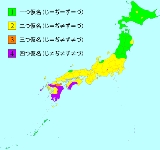
Yotsugana
Encyclopedia

Kana
Kana are the syllabic Japanese scripts, as opposed to the logographic Chinese characters known in Japan as kanji and the Roman alphabet known as rōmaji...
ジ, ヂ, ズ, ヅ (Nihon-shiki: zi, di, zu, du; Kunrei: zi, zi, zu, zu) of the Japanese language
Japanese language
is a language spoken by over 130 million people in Japan and in Japanese emigrant communities. It is a member of the Japonic language family, which has a number of proposed relationships with other languages, none of which has gained wide acceptance among historical linguists .Japanese is an...
. Traditionally four distinct phoneme
Phoneme
In a language or dialect, a phoneme is the smallest segmental unit of sound employed to form meaningful contrasts between utterances....
s, currently they are either one, two, three, or four distinct phonemes depending on dialect
Japanese dialects
The comprise many regional variants. The lingua franca of Japan is called hyōjungo or kyōtsūgo , and while it was based initially on the Tokyo dialect, the language of Japan's capital has since gone in its own direction to become one of Japan's many dialects...
. In the current dialect of Tokyo, it is two phonemes as represented in Hepburn romanization
Hepburn romanization
The is named after James Curtis Hepburn, who used it to transcribe the sounds of the Japanese language into the Latin alphabet in the third edition of his Japanese–English dictionary, published in 1887. The system was originally proposed by the in 1885...
.
Modern kana usage
Historically, spelling differences between the four kana remained even after the pairs of kana were pronounced indistinguishably in Tokyo dialect. Shortly after the end of World War II, however, a new rule enforced the modern kana usage, or Gendai KanazukaiGendai Kanazukai
The is the present official kanazukai . Also known as shin-kanazukai , it is derived from the historical kana usage.-History:...
. The new kanazukai
Kanazukai
are the orthographic rules for spelling Japanese in kana. All phonographic systems attempt to account accurately the pronunciation in their spellings. However, pronunciation and accents change over time and phonemic distinctions are often lost...
unified spellings to just two kana, zi (ジ) and zu (ズ), with two classes of exceptions: when there is rendaku
Rendaku
is a phenomenon in Japanese morphophonology that governs the voicing of the initial consonant of the non-initial portion of a compound or prefixed word...
(e.g. 神無月 かんなづき, kannaduki, where 月 in isolation is pronounced つき, tuki), and when a second duplicate kana is voiced (e.g. 続く つづく, tuduku), when an iteration mark
Iteration mark
Iteration marks are characters or punctuation marks that represent a duplicated character or word.-Chinese:In Chinese, 二 or 々 is used in casual writing to represent a doubled character, but it is never used in formal writing or printed matter...
may be used. An exception to this unification of spelling was permitted for regions that pronounced the four kana as three or four phonemes. After a 1986 update to the Gendai Kanazukai, this exception was replaced with a statement that the unified spelling was to be primarily used, while still permitting etymologically correct spellings.
Modern regional dialects
| Dialects | di (ヂ) | zi (ジ) | du (ヅ) | zu (ズ) |
|---|---|---|---|---|
| Tokyo (standard) | [d͡ʑi], [ʑi] | [d͡zu͍], [zu͍] | ||
| North Tohoku Tohoku region The is a geographical area of Japan. The region occupies the northeastern portion of Honshu, the largest island of Japan. The region consists of six prefectures : Akita, Aomori, Fukushima, Iwate, Miyagi and Yamagata.... , Izumo Izumo Province was an old province of Japan which today consists of the eastern part of Shimane Prefecture. It was sometimes called . The province is in the Chūgoku Region.- History :It was one of the regions of ancient Japan where major political powers arose... |
[d͡ʑi] | |||
| South Tohoku | [d͡zu͍] | |||
| Kōchi Kochi Prefecture is a prefecture of Japan located on the south coast of Shikoku. The capital is the city of Kōchi.- History :Prior to the Meiji Restoration, Kōchi was known as Tosa Province and was controlled by the Chosokabe clan in the Sengoku period and the Yamauchi family during the Edo period.- Geography... (Hata, Tosa Tosa dialect The is spoken in the central and eastern regions of modern day Kōchi Prefecture in Japan. This area was once known as the Tosa area and the name of the dialect still reflects this older name. The dialect itself developed from the linguistic influence of immigrants to the Tosa area from other parts... ) |
[di] ~ [dᶻi] | [ʑi] | [du͍] ~ [dᶻu͍] | [zu͍] |
| Kagoshima | [d͡ʑi] | [ʑi] | [d͡zu͍] | [zu͍] |

